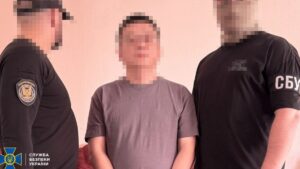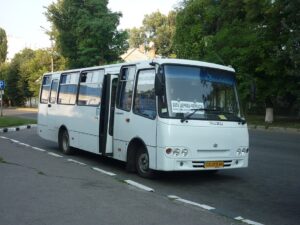
Ukraine has received the third tranche of aid under the ARISE project — over UAH 1 billion, which will be used to support Ukrainian small producers and farms, the Minister of Agrarian Policy and Food said on Telegram.
The minister noted that payments are currently being made in three areas: subsidies per hectare of cultivated land, subsidies for keeping cows, and subsidies for keeping goats and sheep. Payments are being made by the Ukrderzhfond. The Ministry of Agrarian Policy and Food plans to complete them by the end of July.
Producers who are registered in the State Agricultural Register, have submitted their applications on time in accordance with all requirements, did not receive such assistance last year, and are included in the approved lists of recipients are eligible for assistance.

The Ukrainian Security Service’s counterintelligence unit detained two citizens of the People’s Republic of China in Kyiv who were attempting to illegally smuggle classified documents on the Ukrainian RK-360MC Neptune missile system to China.
“This is a unique weapon of the Ukrainian Armed Forces, designed to destroy all types of combat and landing ships. We would like to remind you that it was the Neptune that destroyed the flagship of the Russian Black Sea Fleet, the missile cruiser Moskva,” a statement on Telegram said on Wednesday.
According to the investigation, one of the Chinese spies is a 24-year-old former student of a technical university in Kyiv. He remained in Kyiv after being expelled in 2023 for academic failure.
Another figure in the case is his father, who lived permanently in China but periodically visited Ukraine to personally coordinate his son’s espionage activities. “According to the case file, the former Chinese student was supposed to obtain technical documentation on the production of Ukrainian Neptune missiles.
To this end, he attempted to recruit a Ukrainian citizen involved in the development of the latest weapons for the Armed Forces,” the statement said.
The SBU counterintelligence service exposed the spy at the initial stage of his intelligence activities and detained him while he was receiving secret documents. The next stage was the detention of his father, who was supposed to pass on the secret information to the Chinese special services. During searches of both suspects, phones were seized with evidence of their correspondence, where they coordinated their espionage activities.
Based on the evidence gathered, investigators from the Security Service informed the detainees that they were suspected of violating Part 1 of Article 114 of the Criminal Code of Ukraine (espionage). The suspects face up to 15 years in prison with confiscation of property.

The State Service of Ukraine for Transport Safety (DSBT, Ukrtransbezpeka) issued 176 licenses for passenger bus transportation in January-June this year, compared to 540 last year, 823 in 2023, and 783 in 2022, said the head of Ukrtransbezpeka, Mykyta Lagunin, in an interview with the agency “Interfax-Ukraine.”
“First, the market is already saturated. Secondly, at the beginning of the full-scale invasion, a simplified procedure for obtaining licenses was adopted. But in 2024, this forced norm was revised to take into account European integration aspirations, so there was a return to stricter conditions for issuing licenses,” he explained the dynamics of the reduction in the issuance of licenses.
Lahunin recalled that after the start of the full-scale invasion in 2022, air traffic was blocked, rail transport also has certain restrictions, so there was a surge in bus transportation.
He noted that Ukrtransbezpeka is constantly working to create services that help passengers feel safe and understand who is transporting them today, for which purpose it is opening all its databases. Among other things, the head of the service advised using the Register of Issued and Revoked Licenses on the single state portal of open data (https://middleware.dsbt.gov.ua/lc/licenses).
He also reminded that a service https://autobus.gov.ua/ has been created, where you can buy a ticket directly from a carrier that has all the necessary documents: a license and the appropriate permits to operate on this route.
“In addition, there is a convenient service for checking licensees by vehicle number (https://autobus.gov.ua/). You see a bus, enter its license plate number, and immediately receive all the information: whether it has a license or not,” Lagunin gave another piece of advice.
He noted that for the convenience of passengers and to create equal, convenient, and efficient conditions in the market for carriers, Ukrtransbezpeka is trying to digitize all of its service functions as much as possible.
“Our main body is the Unified Information System Complex, known as EKIS, part of which is EKP, the electronic carrier’s office.
We are focused on developing this tool: we are constantly improving it, adding new modules, and engaging in ongoing dialogue with businesses to get feedback on what else we can improve,” added the head of Ukrtransbezpeka.
As an example of the fight for fair rules in the market, Lagunin cited recent changes to passenger transport regulations, which will come into force in three months, in September this year. According to him, from now on, irregular carriers will be allowed to operate no more than twice a week with one vehicle on one route.
“If you want more, go and get a permit. We have developed an electronic module. The system will not allow you to enter information about a trip more times than required by law. And if a carrier has not entered this trip and is providing transportation, it is automatically considered a violator because it has not declared its intention to transport passengers on this route,” explained the head of Ukrtransbezpeka.
According to the Register of Issued and Revoked Licenses on the service’s website, it currently contains 12,392 entries on valid licenses for passenger bus transportation, of which 3,095 are for international transportation.

Initial registrations of new and used buses (including minibuses) in Ukraine in January-June 2025 increased by 36% compared to the same period last year, to 1,185 units, UkrAvtoprom reported on its Telegram channel.
According to the association, registrations of new vehicles increased by 12% to 534 units, while registrations of used vehicles increased by 67% to 651 units.
In June, demand for buses increased by 11% compared to June 2024, amounting to 154 units, but compared to May this year, when 210 buses were registered, it decreased by 26.7%.
The share of new vehicles in this volume was 48%, compared to 45% last year.
According to statistics from UkrAvtoprom, 17.5% more new buses were sold last month than last year, with Ukrainian buses being the most frequently registered: Ataman from the Cherkasy Bus factory – 27 units (18 last year), Bogdan manufactured by BAS Motor – 12 units (none registered last year), and ZAZ Zaporizhzhia Automobile Plant – 8 units (none last year).
Among used buses, Mercedes-Benz leads with 29 units, followed by VDL (9 units) and Van Hool (8 units).
As reported with reference to data from UkrAvtoprom, in 2024, initial registrations of new and used buses decreased by 19% compared to 2023, to 2,241 units, including new buses by 24%, to 1,296 units, and used buses by 12%, to 945 units.